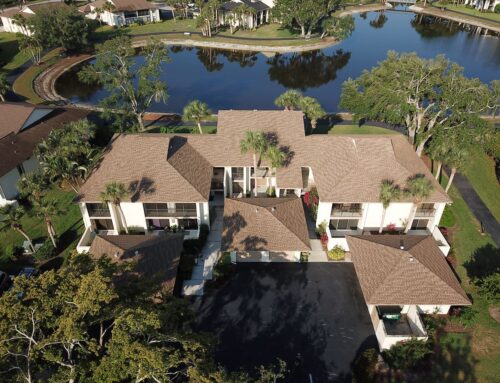How to Spot Roof Damage After a Hurricane
We know that dealing with the aftermath of a hurricane or tropical storm can be incredibly stressful.
You may need to file insurance claims, locate missing items, and assess your home for damage caused by the storm. In some cases, you might even have sustained an injury from the storm.
With so much going on, it can be easy to overlook one of the most important steps: checking your roof damage.
This post 0will tell you everything you need to know about hurricane damage to your roof.
We will help ensure that you understand the different kinds of damage, what you need to look for, and how to respond after a severe storm hits your home.
Then, we’ll tell you where you can find reliable and experienced emergency and post-hurricane roofing repair services.
Understanding The Types of Roof Damage
The first thing you need to know about hurricane damage to your roof?
In general, the damage will fall into one of three categories: wind, water, or hail damage.
Let’s take a look at some of the common signs of these issues below.
HAIL DAMAGE
Hail damage is one of the most prominent types of damage to the spot. This is because you’ll be able to notice indentation marks on your shingles. It would help if you also looked at your car and outdoor furniture.
If they’ve suffered damage?
Then chances are, your roof has, too.
In addition to standard cracks, you should also look for a loss of granules on your roof shingles. For example, you may notice lots of granules washing out of your gutters — a sure sign of hail damage.
Hail damage may not be as severe as other types of roof damage after a hurricane, but it should be taken just as seriously. Hail damage causes the largest amount of storm damage in North America.
WIND DAMAGE
Wind damage is what usually does the most harm to your home’s roof after a hurricane or tropical storm.
Of course, the damage may be pretty evident in some cases — like a fallen tree or branch. However, even if you can’t see it right away, be aware that roof damage caused by winds usually happens once winds reach 50 miles per hour.
You should especially inspect the areas near the edges of your roof, along with the edge lines and corners. This is because the wind doesn’t hit your home’s roof evenly during a storm. It’s easy for the wind to sneak up underneath your shingles, causing them to crack or curl.
Sometimes, the wind may be strong enough to pull shingles off entirely. Check your yard for shingles that high winds have blown off.
Hurricane damage from wind can also cause your roof to lift. This problem is a bit tougher to stop because the shingles look acceptable to the untrained eye in most cases.
The wind has still succeeded in getting up underneath your shingles, causing them to lift upwards and driving the nails loose. In addition to the potential danger of loose nails?
Your shingles’ sealant will also be damaged, which makes you more likely to deal with leaks.
WATER DAMAGE
Of course, the primary hurricane damage to your roof will be water damage.
Like leaks are relatively easy to spot, as are water stains and marks on your ceiling and even on the walls of your home.
However, whether you have an asphalt shingle roof or a tiled option, you need to be aware of less obvious signs of water damage.
First, check your gutters and yard for granules that have come off the shingles, as you did with the hail damage. You should also see if your shingles have cracked, leading to compounded leaks and water damage.
Also, look for wood decking rot due to water damage. If you feel safe getting up on your roof, it will feel somewhat soft when you walk on it. In most cases, this kind of inspection is best left to a professional for safety reasons.
While most people look for signs of water damage on their home’s interiors? It can also happen on exterior walls. This is because the water has damaged the step flashing section of your roof, which intersects with your wall.
Other Possible Roof Damage to Consider
There are several other ways to quickly determine if your roof sustained any damage after a hurricane hit.
Let’s now take a look at some of the places and ways to look for damage.
LOOK AT THE CHIMNEY
Remember that, in addition to taking a good look at the roof itself, you should also examine your chimney for potential signs of damage.
If you spot any missing flashing or loose and cracked bricks surrounding the chimney?
Your best bet is to get in touch with a professional roofing contractor as quickly as possible. Remember that problems with its flashing are common because the chimney settles differently than the roof itself.
Do you notice any cracked joints around the chimney?
This is also an excellent reason to reach out to a professional.
EXAMINE THE GUTTERS
As you’ve likely guessed, your gutters can tell you a lot about the overall health of your roof.
Do they seem to be somewhat sagging? Is the downspout almost filled with debris? Are parts of the gutter damaged or even missing completely?
Remember that repairing your gutters as soon as possible after a storm can help prevent damage from worsening.
It’s straightforward for water trapped in the gutters by debris to freeze, creating ice dams that can be a real pain to deal with. Plus, the weight of the gutters can pull down on the roof, which can cause severe damage to its overall structural integrity.
HEAD TO THE ATTIC
One of the first places you should look when you’re trying to determine the level of water damage a storm caused to your home?
The attic.
Because it’s so close to the roof, it’s often the place where you can first spot the damage. It’s important to remember to check the corners of your attic’s insulation. Leaks and pools of water often begin there.
Be on the lookout for damp spots and any leaks.
The best thing to do is check your attic at the brightest part of your day. This is because it will be easy to spot cracks of light slipping in through holes and leaks in the attic.
BE ON THE LOOKOUT FOR NAILS
Do a quick walkthrough of your yard to look for any nails that might have fallen off the roof.
You should also check out your driveway and flower beds for nails that the wind might have loosened and tossed off your roof. If you can, look for popped nails coming through the shingles.
If you notice that this is a problem for you, speak with roof contractors about using nails that are specifically designed to be more storm resistant than standard models.
DON’T ASSUME YOU’RE IN THE CLEAR
One of the biggest mistakes homeowners often make when assessing the damage to their roof after a hurricane?
Assuming they’re in the clear and didn’t suffer any damage because they haven’t noticed immediate signs.
Sometimes, leaks and pools of water can take several weeks to show up. If you want to be sure, we suggest keeping a close eye on your roof for a few weeks after the storm.
Sometimes, you may want to book a roof inspection to be on the safe side. Remember that hidden dangers and problems are easily missed, especially by someone unfamiliar with roof damage.
Making a more manageable investment in a professional roof inspection after a storm will save you some serious cash.
Now, let’s discuss why moving quickly after a storm hits your home is so important.
Why Acting Quickly to Roof Damage Matters
Now that you understand how to spot some of the most apparent signs of hurricane damage to your roof?
Let’s quickly talk about why acting fast is so important.
Many people don’t realize that storm damage, particularly water damage, can be a considerable fire hazard. Especially if you have any electrical wiring on your roof, you need to turn off your electricity as fast as possible. You don’t want shorted wires to lead to a disaster.
Remember that leaks and holes in your roof will also cause your utility bills to go through the roof. Because hot or cold air slips through the cracks, your HVAC units must work harder to maintain the temperature. This can cause them to wear down quickly, leading to even higher repair costs.
Additionally, it would be best if you thought seriously about the potential health dangers of mold and mildew. Exposure to black mold and other water damage can have serious consequences.
You may deal with respiratory issues, increased allergies, and constant headaches.
Finally, it’s no secret that storm damage to your home’s roof can easily compromise the entire structural integrity of your home. A heavy, weighted-down roof can hurt your home’s foundation in very little time.
You need professional help to repair your roof after storm damage as soon as possible.
Getting a Professional Roofing Contractor for Help After a Hurricane
Especially if you suspect you have more severe hurricane damage, the best thing to do is get in touch with reliable roofing contractors after a storm.
They’ll be able to identify the problems and assess the damage quickly. In some cases, they may even spot issues you weren’t even aware of.
Unfortunately, roofing scams are prevalent after a storm.
Disreputable, unqualified “roofers” may show you photographs of a highly damaged roof and try to convince you that it’s a picture of yours (it’s not.) They may charge you incredibly high fees, insist on payment upfront, then disappear.
You don’t want anyone less than the best working to repair your roof.
Do your homework before a storm hits so that, if the worst happens, you’ll have licensed and insured roof repair companies you know you can trust ready to help you.
Plus, in many cases, attempting a “DIY” approach to roof repair is incredibly dangerous (in addition to being ineffective.) Don’t put your safety at risk. Instead, let the roofing pros handle it.
Let John Rogers Roofing Help You Deal with Hurricane Damage to Your Roof
We hope this post has helped you better understand some of the most common signs of hurricane damage to your roof after a major storm.
In some cases, the damage may be able to be repaired. However, in the case of more severe damage, you may need a partial or complete roof replacement.
Whatever happens, you need to know that you’re working with experienced professionals who can fix your roof efficiently, safely, and effectively.
That’s where we come in.
We offer a wide variety of roofing repair and replacement services. Whether you’re dealing with storm damage or if it’s just time for a new roof, reach out to us today to get started on making things right again.




